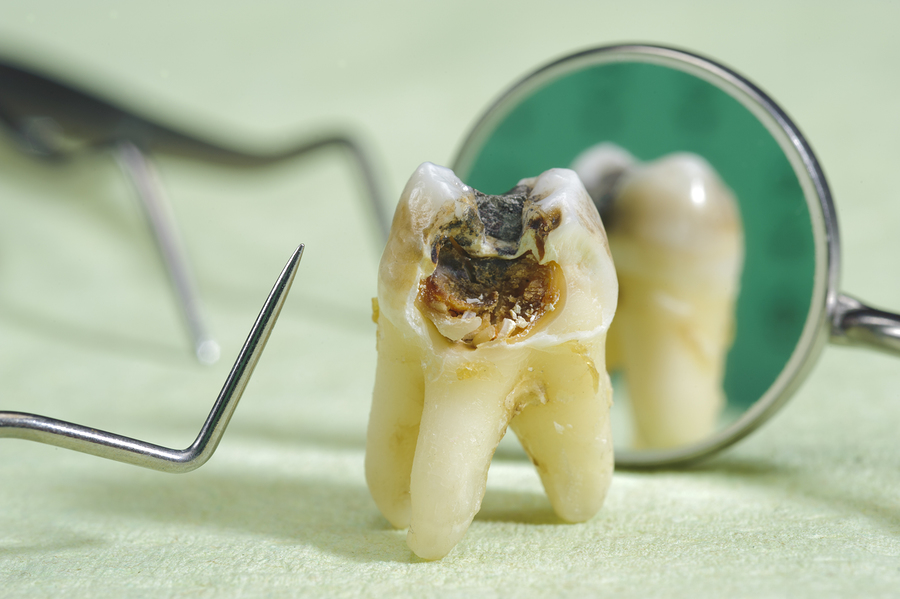What is tooth decay?
Tooth decay is caused by a buildup of acid and dental plaque that wears down the enamel and eventually results in the destruction of the tooth. It affects people of all ages, including children. When tooth decay is left untreated, it can lead to gum disease, dental abscesses and tooth extraction.
What does tooth decay look like
Here is a picture of what tooth decay looks like:

Tooth decay in children
Children are susceptible to tooth decay if the bacteria from their food is left to spread in their mouths. The bacteria found in their mouths will change the foods, essentially making acids, which when left on the teeth can wear down the enamel and create holes in the tooth. When this is left, it causes plaque to form which over time will become hard and can only be removed by a dentist. Failure to attend a checkup for this can result in cavities.
It is important that children follow a proper oral hygiene routine to ensure no food bacteria is left on their teeth.
Are children at a higher risk of tooth decay?

Not necessarily, unless your child has poor oral hygiene or pre-existing problems such as crowded teeth, malocclusion where food bacteria can become easily trapped. Ensuring a proper oral hygiene routine is followed and regular checkups (once every six months) should eliminate the threat of tooth decay.
Tooth decay symptoms
Common signs of tooth decay may include:
- Swelling of the target area (gum, side of the mouth)
- Toothache and pain in neighbouring teeth
- Sensitive teeth (especially hot or cold foods/drinks are consumed)
- Tooth discolouration (black, brown or grey dotted holes appearing)
- Bad breath and an unpleasant taste in your mouth
Tooth decay treatment
It’s important to identify tooth decay early to not only save you multiple treatments but also a small fortune. Caught early, the effects of tooth decay can easily be reversed. Additionally, you may be able to avoid extensive treatment if a cavity is treated before it becomes severely problematic and painful. How your tooth decay is treated depends on the extent of its severity.
Here are the five tooth decay stages:
Okay – Treatment Through Fluoride – for early stages of tooth decay, fluoride treatment is a viable solution. Professional fluoride treatments can effectively reverse signs of tooth decay but only in the very early stages. This type of fluoride is different to what is found in toothpastes only in that it contains a stronger dose of fluoride. This helps to target the decay and fill the areas where decay has entered. This type of fluoride can come in gel, varnish, liquid and foam forms.
Medium – Filling (or restoration) Treatments – when the cavity has progressed to the stage of creating a hole or holes in the tooth, you will require a filling. These can be made out of porcelain, metals or a combination of both.
Bad – Crown Treatment – when the decay has truly set in and has weakened the tooth and any surrounding teeth you may require a crown to replace the decayed area. For this, your dentist will remove the decayed part of the tooth and some of your natural tooth using a small drill to ensure a good foundation is created for the crown. They can be made from metal, porcelain, resin or a combination of materials.
Severe – Root Canal Treatment – if the decay has reached the pulp (the centre of your tooth) you will likely require a root canal. Root canals are only used when the tooth is so badly damaged that only a small portion of the tooth remains. The pulp is removed and placed with a filling. Medication may be applied to the treatment area to ensure any threat of infection is eliminated.
Very severe – Tooth Extraction – a last resort used when the tooth (or teeth) have become so badly damaged that no part is salvageable. The tooth extraction procedure can be performed under either local or general anaesthetic depending on the extent of the surgery. In most cases, if it’s a simple extraction (where the tooth can be seen in the mouth) you will be placed under a local anaesthetic.
In instances where the tooth cannot be seen or has come away from the gum completely, you may require a surgical extraction. This is a more labour-intensive surgical option which is typically performed by oral surgeons and sometimes dentists.
How to stop tooth decay
Tooth decay can be avoided by following a simple healthy oral hygiene routine. This includes all the typical oral healthcare tips, including:
- Brushing and flossing your teeth twice a day
- Using mouthwash
- Having a nutritious, balanced diet and staying away sugary foods and drinks
- Not smoking or drinking alcohol
- Arranging regular checkups with your local dentist (once every six months)
Understanding how to prevent tooth decay can eliminate the need to pay for expensive and less invasive treatment. Booking in with your dentist twice a year will drastically reduce the possibility of tooth decay forming. Brushing and flossing are the most important factors that can keep tooth decay at bay and even reverse the early effects.
When was your last checkup?
All patients should arrange a routine checkup to ensure a good oral hygiene routine is being followed. Even if you do not display any symptoms of tooth decay, it’s advised you attend these checkups to ensure no underlying symptoms are present
You can book a general checkup here today with our Principal Dentist Dimitri Mantazis for more information.




















